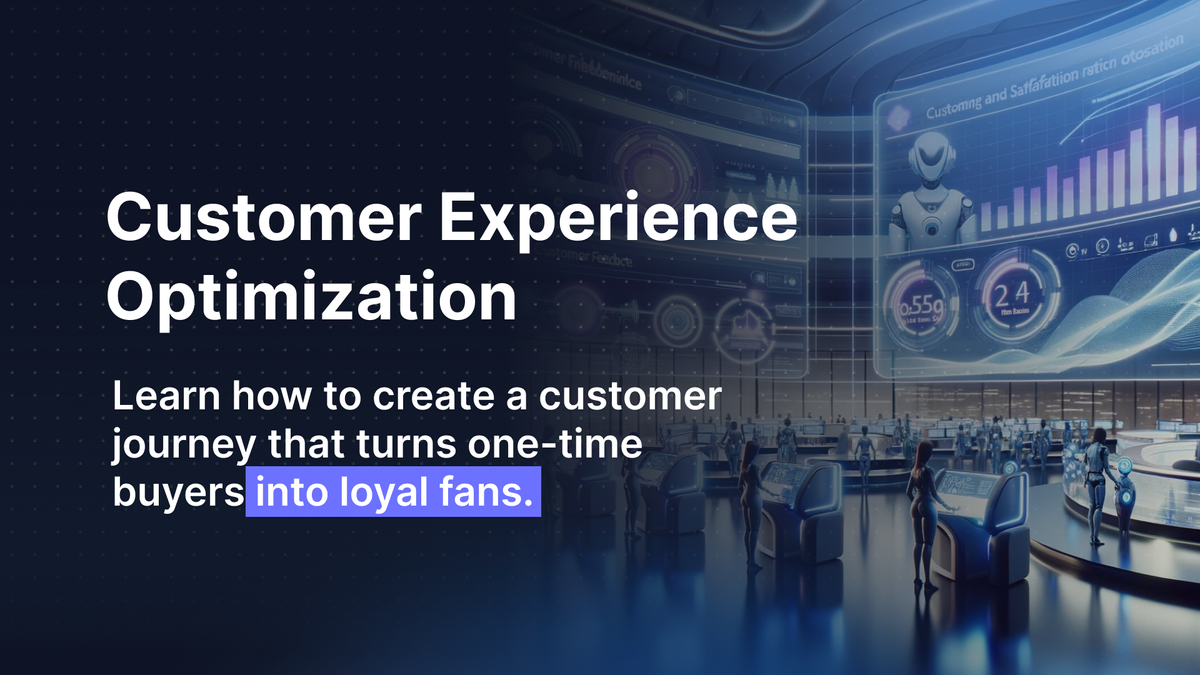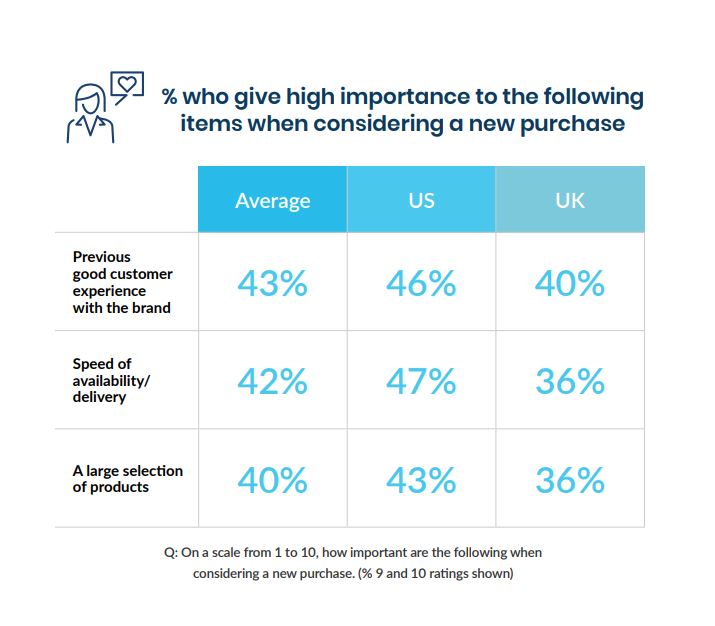Customer experience optimization is the key to thrive in today’s competitive ...

The rise of eCommerce and the digital marketplace have created tremendous opportunities for businesses. While high-quality products and services are crucial, customer experience optimization can set you apart from the crowd. It's a well-planned approach to creating a positive customer journey for your customers.
Research shows that 75% of customers move to another channel if you fail to provide a good online experience. A solid customer service optimization strategy helps you enhance customer satisfaction, build brand loyalty, and enjoy long-term monetary benefits for your business.
Are you curious about how to optimize customer support for an unparalleled experience? This article is a comprehensive guide about all the necessary details.
Customer experience (CX) refers to the holistic perception of your customers about their interactions with your business. These interactions include everything from the website design to product quality or how a service rep chats with them. It goes beyond simply completing an important task and understanding the emotional response of your customers at different touch points with your brand.
In short, it is how a customer perceives their experience with your business, from the initial marketing to the post-purchase customer service.
Before we move on to customer experience optimization, it's important to understand the four types of customer experience.
Customer experience optimization (CXO) is the process of consistently delivering high-quality interactions to customers across all touchpoints. It is a continuous process that uses data, feedback, and analytics to track areas of improvement and implement changes accordingly. These changes aim to optimize the customer journey and make it smooth, efficient, and enjoyable.
Customer experience optimization focuses on three fundamental elements:
This process involves different techniques such as understanding customers' needs, data-driven decision-making, and strong collaboration within different departments, e.g.,. Sales, marketing, and customer support to deliver a unified and consistent customer experience across all communication channels. Below is a customer experience optimization example that will help you understand better:
“An E-Commerce sportswear brand 'Fitlife' was dealing with a decline in customer satisfaction and low engagement on social media due to slow and generic responses. Using customer experience optimization, they trained their social media team, set response time goals, and started live workout sessions with experts. This led to happier customers, better engagement, and improved sales.”
The above example shows how customer service optimization can lead to customer satisfaction, increased engagement, and improved sales.
Studies show that 4 in 10 customers' future purchase decisions are impacted by their experiences with your brand today. This means every positive experience and interaction is an investment in your business's future.

In a saturated market where everyone has similar offerings, an exceptional customer experience is the only way to differentiate you from your competitors. It can transform a one-time purchase into a tribe of loyal customers. Here are some major reasons why customer experience optimization is not a recommendation but an absolute necessity.
The main focus of customer experience optimization is to improve the way a company interacts with its customers. It can involve anything from designing a user-friendly mobile app to quick complaint resolution or compensation. This improves customers' experiences, and they are more likely to return for another purchase and recommend your business to others.
Remember, 74% of customers are at least somewhat likely to buy based on experience alone. Positive interactions with a company are a strong deciding factor for a purchase. For example:
Sarah loves the local cafe's friendly staff, who remember her usual order and often surprise her with a free dessert. Even though a new cafe that offered a discount opened nearby, she remains loyal because of the positive experience at the first cafe.
Customer experience optimization (CXO) is not just about keeping the customers happy but also streamlining your business procedures. It helps you simplify your internal operations and make it easy for customers to connect with you. Think of it as a proactive approach that reduces the need for reactive problem-solving. Customers who have a smooth experience are less likely to reach out for support.
Fewer complaints mean your support staff will spend less time on repetitive issues and focus more on complex problems. Reduced customer service workload allows businesses to allocate resources for other areas like product development and marketing.
Consistently providing high-quality customer experience helps your business grow financially with increased sales and revenue. According to research, 86% of buyers are willing to pay more for a great customer experience. While price is still a consideration, people are willing to pay a premium for a hassle-free buying process and convenient customer service.
Customers who trust your brand and have a positive experience are more accepting of upselling and cross-selling.
“According to Forrester Research, brands that provide excellent customer service bring in 5.7 times more revenue than their competitors.”
On average, acquiring new customers can cost five to seven times more than retaining an old one. This heavy price tag includes marketing costs, promotional offers, and sales resources. Customer experience optimization plays a critical role in customer retention. It offers multiple contact options, empowers agents with knowledge, and quickly resolves issues.
Customers feel valued when their needs are met promptly, and strong relationships are built based on trust and loyalty. This results in low churn rates and high profits. According to a report by Bain and Company, a 5% increase in customer retention can lead to a 25% to 95% increase in profitability.
Customer experience optimization is a continuous process that goes through different stages, such as data collection, segmentation, analyzing customer journeys, and setting long-term goals to create frictionless and positive experiences for your customers.
Here is a detailed, step-by-step guide for you to get started with your customer experience optimization journey.
At Least 56% of companies use data that captures the interactions of the most engaged customers to evaluate which customer segments to nurture. Collecting customer customer feedback and tracking their interactions helps you understand their past experiences and future expectations of your brand.
Here are a few ways to collect customer feedback and data insights for customer experience optimization:
The next step is to analyze and segment your data into different chunks to define your target audience. It is important to get a deeper understanding of your customers before moving towards customer experience optimization.
Data segmentation and analysis familiarize you with different age groups (young tech users, senior citizens, and middle-aged professionals) and their needs. It helps you personalize the process of customer experience optimization.
Once you have segmented your data and defined your target audience, the next step is to re-evaluate the customer journey based on your insights. Divide your customer journey into pre-purchase, purchase, and post-purchase sections and see if it aligns with the needs of different customer segments.
Before moving towards customer experience optimization, identify the areas where your service falls short. For example:
Move forward in your customer experience optimization journey by setting relevant KPIs and evaluation metrics. These benchmarks help you monitor your progress over time and provide a clear roadmap for your optimization efforts. By setting specific goals (reduce cart abandonment rate by 10%), you know what you are working towards.
Here are some of the most relevant KPIs for customer experience optimization.
The above KPIs are examples of general customer experience customization. However, depending on your industry, you may need to add or prioritize different metrics.
After setting your KPIs and implementing changes for customer experience optimization, continuously monitor and adapt your strategies. Here is how:
In addition to the steps mentioned above, here are some best practices to consider during customer experience optimization.
Customers expect a cohesive and convenient experience whenever they interact with your business. This is where the concept of omnichannel support comes in. At Least 62% of customers want to engage with a brand through different communication channels. Omnichannel support creates a unified ecosystem that integrates all communication channels, including in-person interactions, to deliver a seamless customer experience.
For example, a customer browses your website for a new laptop. They initiate a conversation through live chat to clarify specifications, then switch to a phone call for payment plans, and finally purchase the laptop from the nearest store. Omnichannel support enables a service representative to provide personalized and consistent support throughout.

Crafting copy or messages that speak like your target audience is the key to customer experience optimization. It builds connections and makes people feel understood and considered by your business. Take help from real-time insights to get into the heart of your target audience. This will help you create a copy that truly resonates with your customers rather than creating generic sales pitches. For example:
The core of customer experience optimization is creating a customer-centric culture. The well-being of your customers should be the center of everything you do, whether it be customer service, sales, or marketing. Make the best use of customers' data and personalize your interactions.
Here are some practical tips for personalized customer support:
42% of customers leave a website because of poor functionality. A user-friendly interface is critical for customer experience optimization. A clear and concise design guides customers effortlessly throughout their journey, be it finding a product, making a purchase, or getting customer support.

Here are a few tips for a seamless and optimized user interface:
No customer experience optimization journey can occur without the customer service game-changers, i.e., AI Chatbots. These intelligent digital assistants can handle 80% of customer queries and help you boost the customer experience in different ways:
You can speed up the process of customer experience optimization by introducing self-service in customer support. It enables customers to independently resolve their issues and find answers without contacting a customer service representative every time. A well-optimized customer self-service has various tools and resources that empower customers to be self-sufficient, such as:
An effective self-service is only possible if the content is clear, accurate, and readily accessible.
While technology plays a critical role in customer experience optimization, in the end, it's the human interaction with your customer service team that builds trust and loyalty. Continuous training of your staff equips them to deal with different challenges positively:
Here are some of the most common mistakes to avoid during the customer experience optimization process:
Ensure your websites and apps are friendly and well-optimized for the 6.5 billion smartphones.
Too much reliance on technology can leave your customers feeling impersonal. An exceptional customer experience balances automation, technology, and human support.
Implement strict security measures to protect customers' data and sensitive information from thefts and cyberattacks. Keep customers in the loop about how and where you will use their data.
For a truly optimized customer experience, keep all your team members on board regardless of their department. A clear customer-centric vision by leadership can not be executed with proper form from the rest of the employees.
In Conclusion, customer experience optimization (CXO) is a well-planned and strategic approach to creating a positive customer journey across all communication channels for your audience. Businesses can significantly enhance customer satisfaction by collecting customer data, analyzing their feedback, and implementing data-driven decisions.
The use of AI support and AI chatbot customer service is a powerful tool to provide proactive 24/7 support and personalized interaction with customers that gradually results in an exceptional customer experience.
If you are thinking of optimizing your customers’ experience, try Aidbase. We can help you completely transform your customer experience with our AI-powered ecosystem, which includes chatbots, live chats, email, and ticketing automation.